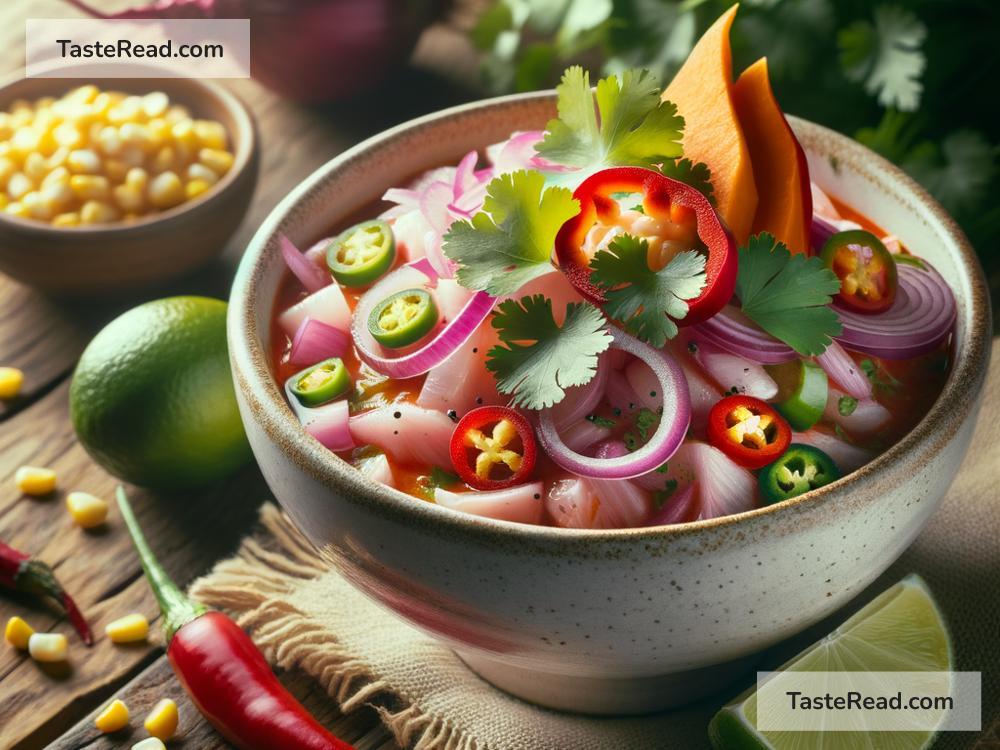The Development of Peruvian Ceviche
Ceviche is one of the most popular dishes from Peru, known and loved by people worldwide. Its fresh flavors, simple ingredients, and unique history make it more than just a meal—it’s a cultural treasure. But where did ceviche come from? How has it changed over time? Let’s take a journey to discover how this delicious dish developed.
What Is Ceviche?
Ceviche is a dish made from fresh, raw fish. The fish is cut into small pieces and “cooked” using lime juice or other citrus juices. This is combined with ingredients like onions, chili peppers, cilantro, and salt to create a dish full of flavor. Often, ceviche is served with sides such as boiled corn, sweet potatoes, or lettuce.
What makes ceviche unique is how the fish is prepared. Instead of using heat, the acid from lime juice changes the texture of the fish and gives it a wonderful taste. This makes ceviche refreshing and light, perfect for hot weather.
The Origins of Ceviche
The history of ceviche goes back hundreds—maybe even thousands—of years. Scholars believe that the dish originated along the coasts of South America. The ancient people of the region, like the Mochica civilization in northern Peru, enjoyed fresh fish from the ocean along with local ingredients.
Before citrus fruits like limes came to South America, people used other acidic ingredients to prepare fish, such as chicha, a fermented corn-based drink. Early ceviche-like dishes involved fish marinated in chicha to preserve it and add flavor. These techniques showed the creativity of ancient cultures, combining natural resources to create delicious meals.
The arrival of the Spanish in the 16th century brought new ingredients and culinary influences to South America. Spanish colonizers introduced limes to Peru, as well as onions, garlic, and herbs. These ingredients combined with the native practices to shape what we recognize as modern ceviche.
Ceviche in Peruvian Culture
By the 19th century, ceviche had become a beloved dish in Peru. It was particularly popular in the coastal areas where fresh fish and shellfish were plentiful. Peruvians embraced ceviche not just for the taste but also for its simplicity and connection to the sea.
Over time, ceviche became a symbol of Peruvian identity. It captures the country’s rich culinary history and diverse influences, blending indigenous traditions with Spanish flavors. Today, Peruvians take great pride in their ceviche, often calling it their “national dish.”
Modern Styles of Ceviche
As Peru’s culinary scene grew, chefs and home cooks began experimenting with ceviche to create their own versions. There are now many styles of ceviche across Peru, each with its own unique flair. Here are some popular variations:
-
Classic Ceviche: This is the traditional style that most people associate with the dish. It uses raw fish marinated in lime juice, onions, chili peppers, and cilantro, with sides like corn and sweet potatoes.
-
Mixed Ceviche: In addition to fish, mixed ceviche includes other seafood like shrimp, squid, or octopus.
-
Black Ceviche: This variety uses squid ink to give the dish a dark color and a deep, rich flavor.
-
Tropical Ceviche: Some chefs add tropical fruits like mango or passionfruit for a sweet twist.
-
Amazonian Ceviche: This version features fish and ingredients from the Amazon region, such as spicy jungle peppers and exotic herbs.
Despite these different styles, the main idea is always the same: fresh, acidic, and full of vibrant flavors.
Ceviche Around the World
In recent years, Peruvian cuisine has gained fame internationally, and ceviche plays a big role in this. It’s not uncommon to find ceviche on the menu at restaurants far beyond Peru. Many chefs in other countries have learned to prepare ceviche using local fish and creative twists.
For example, in Mexico, ceviche is often made with shrimp and features tomato-based sauces alongside lime. In Japan, the dish sometimes takes inspiration from sushi, using sashimi-quality fish mixed with citrus and soy sauce. These adaptations show how versatile ceviche can be, yet its Peruvian roots remain strong.
Why Is Ceviche Special?
Ceviche isn’t just about food—it’s about connection. Every bowl of ceviche celebrates Peru’s geography, history, and cultural diversity. The dish reflects the country’s unique location along the Pacific Ocean, where the sea provides fresh, high-quality fish. It also highlights the blending of cultures that helped Peru develop its vibrant cuisine.
For many Peruvians, eating ceviche is a joyful experience. It’s often enjoyed with family or friends at lunch, alongside a cold drink or beer. In coastal cities like Lima, ceviche shops (called cevicherías) are bustling places where locals and tourists can enjoy the dish together.
Conclusion
The development of Peruvian ceviche is a fascinating story of adaptation, creativity, and pride. From ancient civilizations preparing fish with chicha to modern interpretations with tropical fruits, ceviche has continued to evolve. Yet, at its heart, it remains a simple, refreshing dish that represents Peru’s rich culinary heritage.
If you ever find yourself in Peru, be sure to taste authentic ceviche—it’s an experience you won’t forget. But even if you’re far away, you can try making it at home and get a glimpse of what makes this Peruvian treasure so special.


